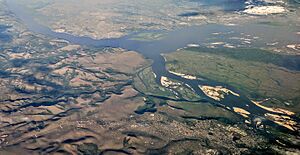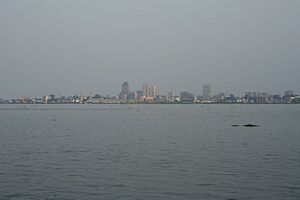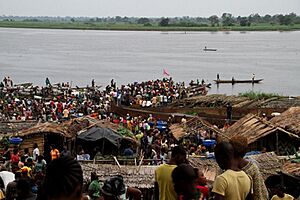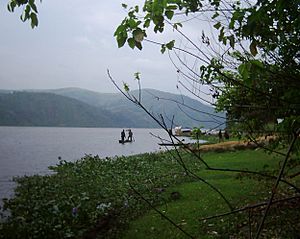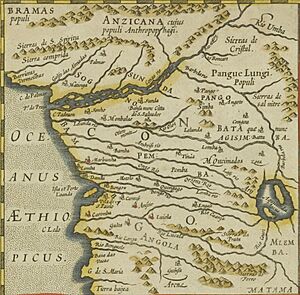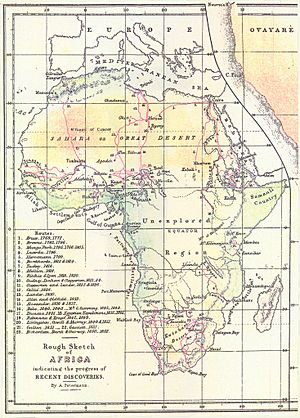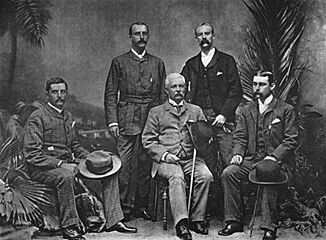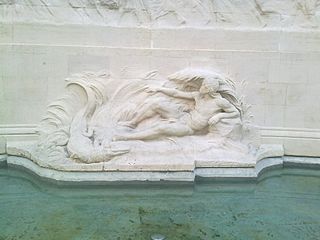Congo River facts for kids
Quick facts for kids Congo RiverFleuve Congo Rio Congo Mto Kongo |
|
|---|---|
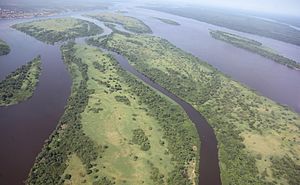
The Congo River near Kisangani, DR Congo
|
|
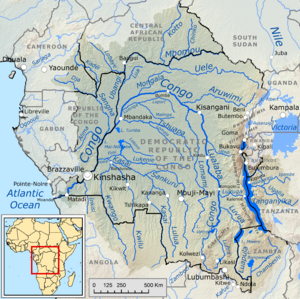
The drainage basin of the Congo River
|
|
| Other name(s) | Zaire River Fleuve Zaïre Rio Zaire |
| Physical characteristics | |
| Main source | Boyoma Falls Kisangani 373 m (1,224 ft) 0°29′33.7776″N 25°12′24.8688″E / 0.492716000°N 25.206908000°E |
| 2nd source | Lualaba Katanga Plateau 1,420 m (4,660 ft) 11°45′52.6212″S 26°30′10.062″E / 11.764617000°S 26.50279500°E |
| 3rd source | Chambeshi 1,760 m (5,770 ft) 9°6′22.824″S 31°18′20.898″E / 9.10634000°S 31.30580500°E |
| River mouth | Atlantic Ocean 0 m (0 ft) 06°04′30″S 12°27′00″E / 6.07500°S 12.45000°E |
| Length | 2,300 km (1,400 mi)
Congo–Lualaba–Luvua–Luapula–Chambeshi 4,700 km (2,900 mi); Congo–Lualaba 4,374 km (2,718 mi) |
| Width |
|
| Depth |
|
| Discharge (location 2) |
(Period: 1947–2023)41,268 m3/s (1,457,400 cu ft/s)
|
| Discharge (location 3) |
|
| Discharge (location 4) |
|
| Discharge (location 5) |
|
| Basin features | |
| Progression | Atlantic Ocean |
| River system | Congo River |
| Basin size | 4,014,500 km2 (1,550,000 sq mi) |
| Tributaries | |
The Congo River, also known as the Zaire River, is a super important river in Africa. It's the second-longest river on the continent, right after the Nile. It's also the third-largest river in the world by how much water it carries, only behind the Amazon and Ganges–Brahmaputra rivers. Imagine this: it's the deepest river ever recorded, going down about 220 meters (720 feet)! The whole river system, including its longest parts like the Lualaba and Chambeshi, stretches for about 4,700 kilometers (2,920 miles), making it the ninth-longest river in the world. The Congo River is special because it's the only big river that crosses the equator twice! Its huge basin covers about 4 million square kilometers (1.5 million square miles), which is a massive part of Africa.
Contents
The River's Name
The name Congo comes from the old Kingdom of Kongo, which was located on the southern side of the river a long time ago. This kingdom was named after the Kongo people, who lived there. The name Zaire comes from a Portuguese version of a Kikongo word, nzere, meaning "river." For a while, people called it the Zaire River, but over time, the name Congo became more common. Today, countries like the Democratic Republic of the Congo and the Republic of the Congo are named after this amazing river.
Where the River Flows
The Congo River's drainage basin is like a giant funnel that collects water from a huge area, covering about 4 million square kilometers (1.5 million square miles). That's almost as big as the entire European Union! The river and its many smaller rivers (called tributaries) flow through the Congo rainforest. This is the second-largest rainforest in the world, only smaller than the Amazon rainforest in South America. A cool fact about the Congo River is that its water flow stays pretty steady all year round. This is because its basin is so big that it covers areas both north and south of the Equator. So, when one part is having its dry season, another part is usually getting lots of rain! The river starts high up in the mountains of the East African Rift, with water coming from places like Lake Tanganyika and Lake Mweru. The Chambeshi River in Zambia is usually considered the very beginning of the Congo River system. From Kisangani, the Congo River flows northwest, then bends southwest. It passes by cities like Mbandaka and joins with the Ubangi River. Eventually, it reaches a wide part called the Pool Malebo (also known as Stanley Pool). Here, the big cities of Kinshasa and Brazzaville face each other across the water. After the Pool Malebo, the river gets narrower and rushes through many rapids and deep canyons, known as the Livingstone Falls. It then flows past Matadi and Boma before finally emptying into the Atlantic Ocean near Muanda. The "Lower Congo" is the part of the river from the Atlantic Ocean up to Kinshasa and Brazzaville. Because of all the rapids and waterfalls, boats can't travel continuously along this section.
River Branches and Friends
The Congo River has many tributaries, which are smaller rivers that flow into it. These tributaries bring water from all over the huge Congo Basin. Some of the most important ones include the Kasai, Ubangi, Lomami, and Aruwimi. Each of these rivers is like a branch of a giant tree, all contributing to the mighty flow of the Congo.
Why the Congo River is Important
Even though the Livingstone Falls make it hard to travel directly from the sea, much of the Congo River is like a highway for boats. Big river steamers used to travel here a lot. The river is still super important for transportation in a region where there aren't many roads or railways. Many goods travel along the river, including things like copper, palm oil, sugar, coffee, and cotton.
Power from the River
The Congo River is the most powerful river in Africa. During the rainy season, a huge amount of water, over 50,000 cubic meters (1.8 million cubic feet) per second, flows into the Atlantic Ocean. This means there's a lot of potential to create hydropower, which is electricity made from moving water. Experts believe the Congo Basin could provide 13 percent of the world's hydropower. This would be enough electricity for all the countries in Sub-Saharan Africa! Right now, there are about 40 hydropower plants in the Congo Basin. The biggest ones are the Inga dams, located about 200 kilometers (120 miles) southwest of Kinshasa. These dams help generate electricity. There are plans to build even more dams, which could create a lot more power. However, some people are concerned that new dams might affect the many unique fish species that live in the river.
Amazing Nature of the Congo River
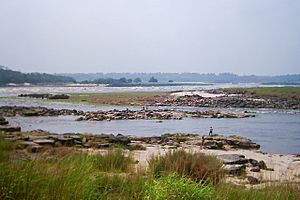
The Congo River as we know it today formed between 1.5 and 2 million years ago. Over time, it "captured" water from other river systems, making its basin even bigger. The river's formation might have even helped create two different types of apes: the bonobo and the common chimpanzee. These two apes are very similar but live on different sides of the river. The bonobo lives only in the humid forests of this region. Other special animals found here include the Allen's swamp monkey, dryas monkey, aquatic genet, okapi, and Congo peafowl. The Congo River Basin is home to an incredible variety of aquatic life. It has one of the highest numbers of different fish species in the world, with almost 800 types recorded! Many of these fish are found nowhere else on Earth. Scientists are still discovering new species in this vast river system. Compared to other African rivers, the Congo has by far the most diverse fish population. For example, the Livingstone Falls alone have over 300 fish species, and about 80 of them are unique to that area! One of the most famous fish here is the huge, meat-eating giant tigerfish. There are also some very unusual fish, like the whitish (non-pigmented) and blind Lamprologus lethops, which is believed to live deep underwater, and Caecobarbus geertsii, the only known cavefish in Central Africa. Many unique frogs and snails also call this river home. As mentioned before, new hydroelectric dams are being planned. While they provide power, there's a worry that they could cause some of these special fish species to disappear forever. Several types of turtles and different kinds of crocodiles, like the slender-snouted, Nile, and dwarf crocodile, live in the Congo River Basin. You can also find African manatees in the lower parts of the river.
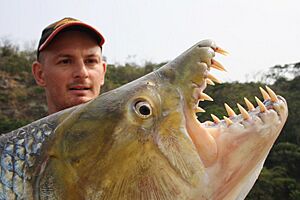
A Look Back in Time
Early History
The entire Congo basin has been home to Bantu peoples for a very long time, divided into many different groups. These groups started moving into the middle Congo around 500 BC. Some of the original inhabitants, called Pygmies or Abatwa, still live in the remote forest areas. By the 13th century, there were several important groups of states in the western Congo Basin. The Kingdom of Kongo was formed in the late 1300s near the lower part of the river. European explorers first reached the Congo in 1482. A Portuguese explorer named Diogo Cão discovered the river's mouth. He sailed a short distance up the river and met people from the Kingdom of Kongo. However, the full path of the river remained a mystery for many years. In the 19th century, trade routes, where people were sometimes taken captive, reached the upper Congo River. David Livingstone was a European explorer who reached a trading post called Nyangwe in 1871. He saw a sad event where many Africans lost their lives due to these traders. This experience was so upsetting that he decided not to continue his journey to find the sources of the Nile River.
European Exploration and Settlement
The central parts of the Congo basin were largely unknown to Europeans until Henry Morton Stanley's expedition in 1876–77. People wondered if the Lualaba River (an upper part of the Congo) flowed into the Nile, the Congo, or even the Niger River. Stanley started his journey in Zanzibar and reached the Lualaba in 1876. He hired some local people to help him travel through the dense Matimba forest. His journey was very challenging, with many difficult encounters with local groups who were wary of outsiders, often because of past experiences with traders who took people captive. In January 1877, after traveling a long way, Stanley reached the Boyoma Falls (which he called Stanley Falls). These were a series of seven waterfalls that his team had to bypass. Here, he learned that the river was called Ikuta Yacongo, which confirmed he had found the Congo River. After five months of difficult travel down the Livingstone Falls, Stanley and his team finally reached the Portuguese outpost of Boma in August 1877. His journey had taken 1,001 days, and many people on his expedition had faced illness, hunger, or other dangers. Later, in 1881, Stanley founded a trading post that became Kinshasa. It was named Léopoldville at first. The Congo Basin then became known as the Congo Free State. This was a challenging period for the local people. Eventually, the region became the Belgian Congo.
Images for kids
-
An aerial view of the Lukenie River winding through the Central Congolian lowland forests.
-
The Ubangi River.
-
The Ruzizi River.
See also
 In Spanish: Río Congo para niños
In Spanish: Río Congo para niños
- 2021 Congo River disaster
- List of crossings of the Congo River
- List of rivers of Africa
- List of rivers by discharge
- List of rivers by length


